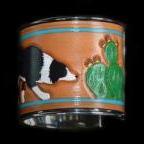
CuttingHorse
Members-
Content Count
11 -
Joined
-
Last visited
About CuttingHorse
-
Rank
Member
Recent Profile Visitors
1,315 profile views
-
Learning About Saddle Repairs
CuttingHorse replied to CuttingHorse's topic in Saddle Identification, Restoration & Repair
I just looked up their saddlery course. Have you heard good things about their courses? I'm intrigued by the classes they offer, though it looks like I wouldn't be a certified Master Saddler/fitter/etc? Did I misread that? Where would a college course like that put me skill wise? I can see the time factor being an issue, it looks to be a two year course to take, assuming there aren't other courses to take before. -
CuttingHorse started following Different Brands Of Tools, Need strap ideas for purse, Learning About Saddle Repairs and and 1 other
-
Learning About Saddle Repairs
CuttingHorse replied to CuttingHorse's topic in Saddle Identification, Restoration & Repair
Thank you, that's what I was thinking! I just wasn't sure since the cost to repair something like that would probably sky high. Although, if this is the Tad Coffin saddle I think it is, replacing all the exposed leather pieces would still be cheaper than buying a new saddle. -
Learning About Saddle Repairs
CuttingHorse replied to CuttingHorse's topic in Saddle Identification, Restoration & Repair
Thank you so much for all the information! Y'all are really helping me a lot! @fivewayswelshcobs Are there still any colleges that do leather courses? That sounds like heaven, much more lively than the college courses I'm currently taking. I may end up going into either fitting or repair instead of both, but I want to keep my options open until I decide for sure. There's a lot of options out there! That's a nice set up though! It sounds like you have lots of toys to play with. I feel like it's a leatherworker's burden to constantly be finding space for a new toy, there's just so many tools to collect! How do you organize your customer's saddles that come in for work? That's something I've been mulling over, short of having a separate room dedicated to storing saddles. @gmace99 That was my thinking. If I can build it from the ground up, then I should be able to take it apart and fix it. One question for you, what would you recommend to continue my education on saddle making/repair after your class? I wouldn't be comfortable doing repairs after building one saddle. Should I go on to take the SMS course or is there a different way? I've heard of Custom Saddlery! That's a fantastic saddle that Cary puts out. @Old Coach Saddlery That was my thinking with the NASS. It's a good starting point for a thorough education and I can build up connections. I've also heard that the owner Annette will help her students who have graduated the course, which is nice to hear. It's good to know that a large workshop isn't needed, that will cut down on my costs a bit! I'm currently thinking a 30X30 space just to give me plenty of room. I know, I'm really jumping the gun planning my workshop, but I'd like to start thinking about what I want/need and saving for it. Another question for y'all(sorry), but with repairing saddles, where would you learn how to restore saddles? I ask because I was looking at repair pictures by a saddlery and they had a picture of a Tad Coffin saddle that looked brand new in the after pictures. I'm not looking to steal their techniques or anything, I'm just intrigued by how they had managed to restore it to something that I would buy new from a tack store, short of rebuilding the entire thing. Here's a link to the website, the saddle is on the slideshow on the right. https://www.dutchessbridlesaddle.com/saddle---tack-repairs.html Thank you again for all of y'all's help, I'm learning a lot! -
Learning About Saddle Repairs
CuttingHorse replied to CuttingHorse's topic in Saddle Identification, Restoration & Repair
Thank you, this helps a lot! I do feel as though I’m going two different directions with fitting and repair. It’s not helping my confusion at all. You bring up a good point about there being fitters out there who do a shoddy job. Same goes for repairs. I’m trying to avoid that, as I want to be competent at what I do, not just good enough to do a passable job. I had previously looked into the County fitting course but opted against it, I found out it was a course to teach you how to sell County saddles, not how to fit. I don’t want to be a product pusher. The NASS is affiliated with the SMS, which is awesome because it’s easier for me to take classes in the states. I could travel to the UK and will probably end up doing so for courses, but currently I am hesitant to do so due to all the ties I have in the states. I could definitely make it work for a few years if need be, but I wanted to keep that as a backup plan. Do you think it would be possible to juggle both fitting and repairs? Or would I be better off choosing one or the other? I think I will learn fitting first, as the start up is easier on that, then start collecting tools and machinery to do repairs as I get built up, if I am able to do both at the same time. I wills shoot George an email to get more info, thank you! I notice there is a class on building a saddle, have you had any experience with that? That’s a decent sized workshop you have! Also a nice spread of equipment to work on. I would love to see pictures of your workshop and your leatherwork if you want to share. Thank you again for all the info you have given me, you’ve given me a lot to think about and consider. -
Hello all, I’m the lurker of the forum, finally coming into the light to hopefully be more active. I did have a question for everyone. I am interested in becoming a saddle fitter, which is kind of overwhelming to learn about since learning the profession is so underground, at least in the US. I posted a thread on a different forum for advice from other fitters, and have learned a lot. It’s also help clear up any confusion and give me a clearer picture. Long story short, my current plan is to take classes at the North American Saddlery School(NASS), then receive my certification through the Society of Master Saddlers(SMS) in the UK. Something else I’m interested in is doing repairs. My area has one saddle fitter that stays overbooked. She also does minor repairs, but again, she stays too booked. It’s to my understanding that she has stopped doing repairs in the last few years due to the workload. So there’s not really anyone who does repairs locally. I know I will learn how to drop panels and replace flocking while learning how to fit, but I would like to be able to do other repairs such as billet replacement, knee pad replacement, seat replacement, etc. Where would I learn to do repairs? Would that come from learning how to build a saddle? My current focus is English saddles, though I would be interested in learning either western or side saddle repairs also. I suspect doing all three would be stretching myself too thin, and that’s not something I want to do. Another question, I’m full of them sorry, but approximately how big of a workshop would you want to have for a saddle fitting/repair business? What are the bare bones tools that you would need? Ideally I would like to have my workshop on property with me when the time comes to build one, the way I’m not paying rent on a facility and can be home more, but I would hate to build a shop only to figure out that it wasn’t well designed or built big enough for what I need. Thank you in advance, and sorry for all the questions! I’m trying to explore all my options and figure out what the best route to take would be. Any advice you can give would be greatly appreciated, along with any experience you would like to share. Sorry if this is the wrong forum to put this in, it seemed like the best fit. Please move it if this is incorrect.
-
Oiling A Saddle
CuttingHorse replied to CuttingHorse's topic in Saddle Identification, Restoration & Repair
Thanks y'all! CWR, I'm not sure if it is considered a rough out, it probably is. I started taking it apart a couple of nights ago, the seat jockey is nailed to the swells. Can I remove the nails then put new ones in using the same holes? Or would that loosen the fit? I hope that makes sense, I'm really bad at describing things. Again, thank you for answering my dumb newbie questions! -
Hey y'all, I'm dying a money clip with Eco Flo dye, and it won't take in certain areas. I used one coat of a Eco Flo finish before dying, hoping it would bring out some highlights and lowlights, but it won't take in certain areas. I've used this trick before and never had problems. I've already lightly sanded off the dye once, do I need to do it again? I attached a picture to show what it's doing. Thanks!
-
I've been doing leather crafting for a few years but just recently discovered the tool makers beyond what Tandy sells. I've had my eye on some Barry King tools, and I was wondering, are they worth it? Can you see a drastic difference in the tooling or is it just a better quality tool? The same questions apply to the mallets they sell. Is there another brand aside from Barry King that is recommended? Thanks in advance!
-
I wasn't sure where to put this so I hope this is the right place! I have an old cutting saddle that I bought a few years back. It hasn't been well taken care of, and as a result squeaks really badly. It's suede, so any oiling I do doesn't work very well, and I'm starting to consider taking it apart so I can get to the grain side of the leather and give it a good oil. From what I can see(looking under the upper skirt), the grain side is in lovely condition, just dry from neglect. Can I take it apart and clean it or would it mess my saddle up? I've been doing leather crafting for a few years but saddle construction is completely foreign to me. I would like to learn more about the process and how to do it though! I thought about asking a repair shop if they would take the saddle apart and oil it for me, but I don't know of any saddle shops nearby. The only one I know of closed down a few years ago. Also, what would be recommended for oiling a dry saddle? I've been using the Lexol oil, but just wondered if there was anything that would work better. Any help is appreciated!


